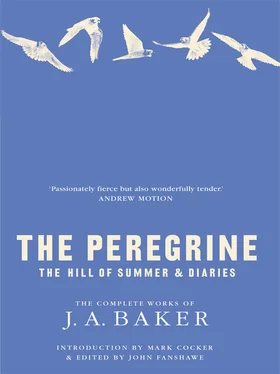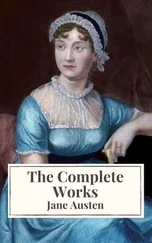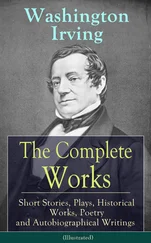Those lucky enough to own an early copy of The Peregrine treasured it. In The Running Sky, Tim Dee writes: ‘the peregrine in my young mind was built by J.A. Baker’s The Peregrine. I read it when I was eleven, it stole into my head and stayed there, and then I reread it compulsively.’
What was it about the enigmatic Baker’s writing which so captured the imagination of later writers like Macfarlane and Dee? These were the years following the publication of Rachel Carson’s Silent Spring and, as Baker concluded in his own introduction, ‘Few peregrines are left, there will be fewer, they may not survive. Many die on their backs, clutching inanely at the sky in their last convulsions, withered and burnt away by the filthy, insidious pollen of farm chemicals. Before it is too late, I have tried to recapture the extraordinary beauty of this bird and to convey the wonder of the land he lived in, a land to me as profuse and glorious as Africa. It is a dying world, like Mars, but glowing still.’
Without doubt, Baker would have been amazed and delighted that peregrines have recovered so successfully, returning to many traditional sites, as well as breeding in cities and towns around Britain, including London, not least the celebrated pairs that are nesting on both the Houses of Parliament and Tate Modern. This recent recovery was in no way apparent in Baker’s lifetime or to a generation of writers growing up in the 1960s. Tim Dee writes that he ‘grew up thinking of Peregrines as sickly’. ‘The magnificent hunter, the apotheosis of the wild, the falcon on the king’s gloved fist, was becoming as helpless as a spastic battery hen, a bird that broke its own eggs.’
In the nineteenth century, peregrines had suffered from a host of troubles; notably persecution by gamekeepers and pigeon fanciers, but also the depredations of egg collectors. Though numbers had stabilized by the 1930s, the Air Ministry authorized widespread culling to save carrier pigeons at the outbreak of WW2, and several hundred birds were exterminated. By the 1950s, numbers had started to recover, but then a new and catastrophic decline began. As Baker lamented, it was the chemical ravages of organochlorine pesticides that killed adults and thinned their egg shells into fracturing. The story is now well known, and related by the late Derek Ratcliffe in his epic monograph on the peregrine, but when Baker was walking the Essex countryside, persistent pesticides were still paramount in the minds of the newly emerging conservation community as a threat to the birds that occupied the land and seascapes he loved and celebrated in all his writing. Peregrines were totems of a wilderness under siege.
In 2009, as Mark Cocker and I prepared the new edition of The Peregrine, The Hill of Summer, and the edited diaries, growing interest in J.A. Baker had revealed a little more about his life, and in Mark’s introduction, and my own introduction to the diaries, we outlined the new material that had come to light when the film-maker David Cobham visited Baker’s late widow, Doreen, and was given his diaries. This began a process that has already and will, we hope, continue to reveal insights into the author’s life and influences. Chief among these have been meetings with his school contemporaries, and the discovery of a small collection of letters. In the longer term, we hope to establish an archive of these papers, but, in the meantime, and with the arrival of this paperback edition, there is a chance to reveal a little more of what has been learned.
John Alec Baker, only son of Wilfred and Pansy Baker, was born on 6 August 1926. His father worked as a draughtsman for the engineering company Crompton Parkinson and, we believe, spent time as a borough councillor, and later mayor of Chelmsford. The family lived at 20 Finchley Road, and Baker attended Trinity Road Primary School nearby from 1932 to 1936.
One of the first signs that Baker was a bright child appeared when he won a Junior Exhibition to the King Edward VI Grammar School. Details of his early days there remain hazy, but three of his close friends from this time, Edward Dennis (who became Baker’s best man), John Thurmer (who went on to become Canon of Exeter Cathedral), and Don Samuel (who became an English teacher), have provided further insights into Baker’s later school life. It has emerged that in 1942, after he had completed his General School Certificate, he stayed on an extra year. It was wartime, so the school was often disrupted, and only four other boys were studying the arts at that time. Baker joined them, and although he did not study for the Higher School Certificate, he enjoyed a year of ‘supervised’ reading under the wing of a charismatic English teacher, the Rev. E.J. Burton.
Exactly why Baker was allowed this apparently unusual extra year is unknown, though Thurmer recalls that he was often absent from school with ill heath, including glandular fever, and early bouts of the arthritis that crippled him in later life. Possibly staff at KEGS – as the school was known – were sympathetic to this, and felt Baker deserved some more time.
Other scraps of information have emerged. Nicknames were commonplace and Baker was known as Doughy. This was a play on his name, of course, but he was stocky, and, it seems, someone with whom you’d be unlikely to pick a fight. Despite his bouts of ill health, and disarming short-sightedness, Baker did play cricket. A school magazine report describes him as: ‘an erratic bowler, whose chief fault is an inability to maintain length. He is lacking in confidence, but shows great promise.’ Still, his friends all remembered him being keenly anti-establishment, and rather obsessive. No-one could remember an interest in birds at school – which accords with Baker’s own admission that ‘I came late to a love of birds’.
Bright enough to be allowed to stay on into the Sixth Form, given to bouts of ill health, with a passion for reading, and a little rebellious, Baker is remembered very warmly by his friends. At the end of his time at grammar school, John Thurmer recalls, the Sixth Form master said that Baker had ‘enjoyed some general reading, but had not exerted himself’. Don Samuel goes as far as to describe him as talented, though bone idle, but notes that he was an avid reader, and literally, to quote Samuel, ‘sated himself in books’. He also recalls that Baker loved Dickens, and liked to genuflect light-heartedly before his novels in the Sixth Form library.
In 1943, his contemporaries left school to join up, a fate which Baker’s short sight ruled out. It appears that this might have been the period when, as the original biographic sketch suggested, Baker undertook the earliest of his unsuccessful ‘fifteen assorted jobs’. Information is scant but Samuel says that Baker liked to work outside – the best environment for his health – and recalls him apple picking in the orchards around Danbury Hill, east of Chelmsford.
All three friends remember that Baker was a keen correspondent while they were overseas in the forces, regularly sending them letters full of news, and examples of his writing – including early poems. With great prescience, Don Samuel had kept some letters and these, largely written between 1944 and 1946, provide new insights into Baker’s development. They also confirm that he did, indeed, work behind the scenes at the British Museum (although he left after just three months). Most are written from his parental home in Chelmsford, but they include letters written from North Wales, Cornwall, and Oxfordshire, revealing a first-hand knowledge of land and seascapes that appear in both The Peregrine and The Hill of Summer. In August 1946, for example, he writes to Samuel: ‘On Monday, I took trains from Paddington for Stow-in-the-Wold, and I have started enquiries concerning farm-work. I have arrived a little too early for the harvesting, but I have persevered, and obtained several half-promises from the landed-gentry’.
Читать дальше












